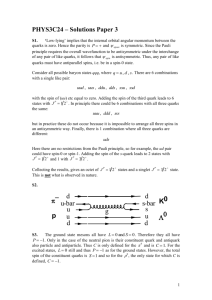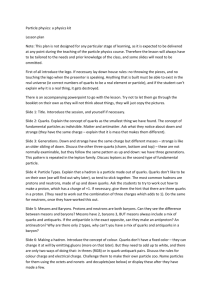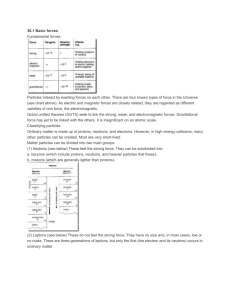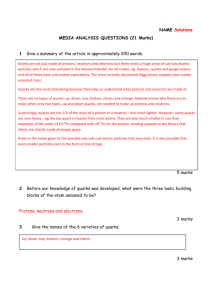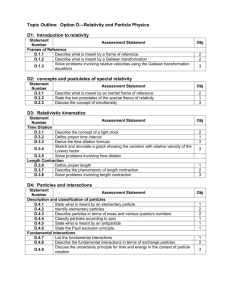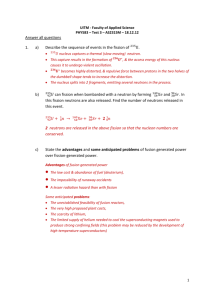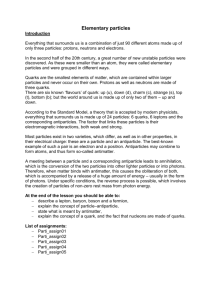Quest for connecting Quarks to the Cosmos - WCU-q2c
advertisement
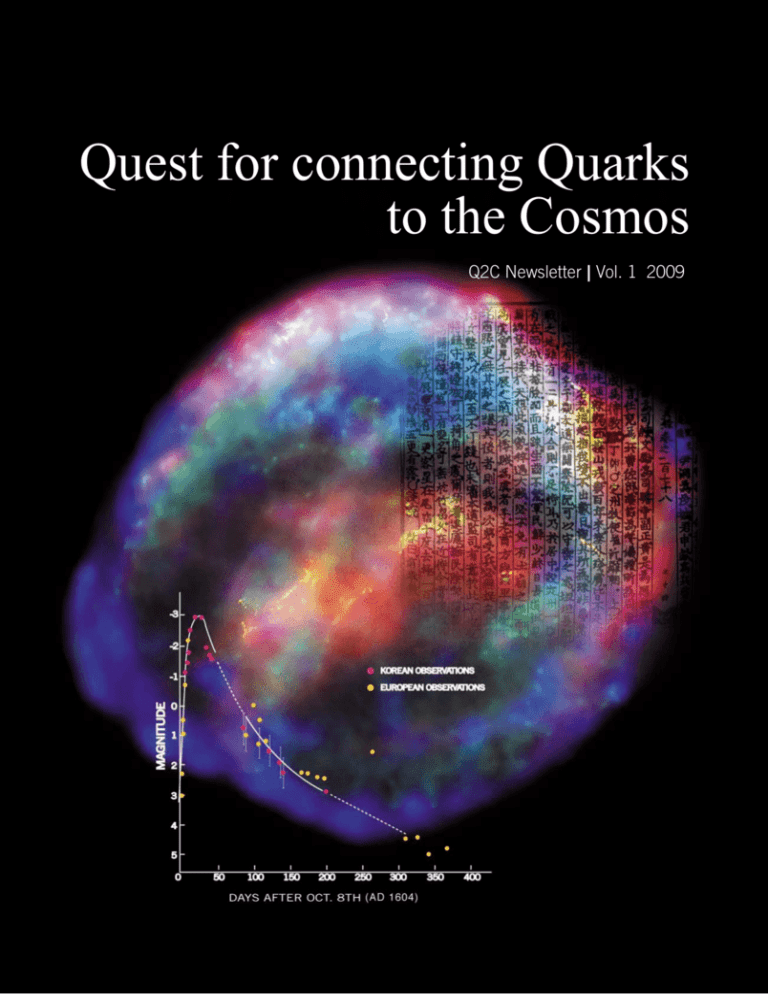
Quest for connecting Quarks to the Cosmos Q2C Newsletter | Vol. 1 2009 Q2C, WCU Center for High Energy Physics Department of Physics and Astronomy Seoul National University 599 Gwanak-ro, Gwanak-gu, Seoul 151-742, Korea http://q2c.snu.ac.kr/ Cover Story The last supernova in our Milky Way exploded in the year 1604. This supernova, widely known as Kepler’s supernova, was also observed by Korean royal astronomers during the Chosun dynasty and duly recorded in Chosun Silok, the official annals of the dynasty. The Korean observations also include comparisons of the brightness of the supernova with Jupiter. These observations, combined with those from European observation, permit us to trace the change of its magnitude with time. Moreover, it can be shown that the decrease of the magnitude is compatible with the decay time of the 56Co nucleus. This work can be considered as one of the first examples of profitable international cooperation in science. Supernovae explosions are one of a class of extraordinary events that connect the subatomic world of quarks and nuclei to the cosmic world of stars and galaxies. Detailed microscopic phenomena that occur during supernovae explosions are one of the key research areas of our Quark-to-Cosmos WCU team. The cover of the Newsletter shows the corresponding page of Chosun Silok where the first sighting of the supernova is recorded; the magnitude versus time plot composed of both western and Korean observations are superimposed on a recent photo of the supernova remnant in the constellation of Ophiuchus, or snake-holder. Publication date : October 2009 Published by Sun Kee Kim Design and printing by KyungHee Information Printing Co., Ltd. Seoul National University Greetings 04 Message from the director Participating Professors 06 Stephen Lars Olsen Contents Hyoung Chan Bhang Sun Kee Kim Seonho Choi Yoshiteru Sato Kiyoshi Tanida Research Program 09 The KIMS Experiment Experiment on Double Beta Decay Search The Belle Experiment The BES Ⅲ Experiment Hadron Physics with Electron Beams Experiments at RIKEN RIBF Strangeness Nuclear Physis at J-PARC Baryonic Weak Interaction Study in Hypernuclei Essays 18 Newsletter Essay Stephen Lars Olsen In September Myeongjae Lee Life in SNU Kiyoshi Tanida Members 24 Research Professors and Research Associates Graduate students Staff Members Message from the director Message from the director I believe that Korean system has its own merits, but we should try to learn to recognize and adopt good parts of different systems, so that we can create a new and improved system that can provide comfort, much like wearing a modernized hanbok combines the elegance and traditional features of the original design with modern serviceability and convenience. 04 When the World Class University (WCU)Program was first announced, at first glance I frankly was skeptical about the necessity for such a program. Over time, after giving it some deeper thought, I reached to the conclusion that we could make it a success if we could effectively utilize the optimistic side of the program, namely, inviting excellent foregin researchers whom we could not normally expect to attract to Korea for a long-term commitment. In the Q2C (Connecting Quarks to the Cosmos) program, we were fortunate to be able to use WCU resources to attract three distinguished foreign scholars as full-time visiting professors to Korea (the same number as domestic participants in our team). As indicated in the title of our team, Q2C, the goal of our project is to develop into one of world’s leading research groups that produces top-class research results in the newly merged fields of elementary particles, nuclear physics and astrophysics. We carry out experiments searching for dark matter and neutrinoless double beta decays in an underground research facility at Yangyang, Korea. At the same time, we will make important contributions to nuclear, particle and astro-physics through experimental programs at various particle accelerator laboratories abroad. Seoul National University Sun Kee Kim Q2C Newsletter (Vol.1) 2009 It has not been that easy for the foreign scholars to establish themselves in Korea. However we can already feel a lot of changes that are being made through the active participation of foreign scholars in seminars, meetings, lectures, advising students, and even some administrative matters. Everyday communication in English is only a minor change. We are finding out many problems that have not been issues for us for many years and we are finding out things that we lack that are needed to make progress toward becoming one of the world’s leading universities. On the other hand, I am beginning to worry, hopefully unnecessarily, that foreign members may adapt too well to our system so that they become more like us, before we change sufficiently. I believe that Korean system has its own merits, but we should try to learn to recognize and adopt good parts of different systems, so that we can create a new and improved system that can provide comfort, much like wearing a modernized hanbok combines the elegance and traditional features of the original design with modern serviceability and convenience. Sun Kee Kim Professor Department of Physics and Astronomy Seoul National University Quest for connecting Quarks to the Cosmos 05 Participating Professors Stephen Lars Olsen Participating Professors Stephen Lars Olsen’s research is mainly concentrated on studies of the properties of subatomic particles containing charmed quarks (c-quarks) or beauty quarks (b quarks). Studies of the decays of particles containing b-quarks are useful for studying differences between the properties of matter and those of antimatter. Studies of the properties and spectrum of particles containing c-quarks provide unique understanding about how quarks combine with each other to form particles. This research is done with the Belle experiment at the KEK laboratory in Japan, the world's best facility for studying b-quarks and with the BES III experiment at the Institute of High Energy Physics in Beijing, China, the world's best facility for studying c-quarks. Olsen is a charter member of the Belle & BES III experiments and also participates in the KIMS experiment in Korea. Hyoung Chan Bhang Hyoung Chan Bhang’s research has been mainly concentrated on the weak interaction including those of strange particles by measuring the decay of hypernuclei. He has measured the lifetimes of strange particles placed inside nuclei from carbon to Yttrium, thereby finding its saturation phenomena with respect to the mass number. He has recently reported results on the partial decay widths of hypernuclei which finally resolved the long standing puzzle of the strength ratio of the neutron to proton induced weak decay. He showed that the puzzle is intimately related to the unexpectedly strong contribution of three-body process in the baryonic weak interaction in nuclei. He is the spokesman of the next generation weak decay experiment (E18) at J-PARC in which the outstanding issues of the decay of hypernuclei will be examined in detail. He also participates in the KIMS experiment and in the experiments on the extreme neutron rich nuclei at RIBF of RIKEN laboratory. 06 Seoul National University Sun Kee Kim Seonho Choi Seonho Choi is mostly interested in the question of how matter is built up from elementary building blocks. For example, nuclei are composed of protons and neutrons while the latter are in turn, made from quarks and gluons. To achieve this goal, he is conducting experiments at Jefferson Lab in the U.S. which has the world's highest energy electron beams. In the future, he is planning to study exotic nuclei with Rare Isotope beams at facilities in Japan & the U.S. and, ultimately, in Korea. Quest for connecting Quarks to the Cosmos Q2C Newsletter (Vol.1) 2009 Sun Kee Kim leads the KIMS experiment that searches for signals of direct interactions of dark matter particles with ordinary nucleus in a large array of CsI(Tl) crystal detectors located in the Yangyang Underground Laboratory in eastern Korea. He is developing new types of ultra-sensitive detectors for use in next-generation double-beta-decay and dark-matter searches. Recently, he is leading an effort to realize the experiment that searches for neutrinoless double beta decays with newly developed CaMoO4 crystal detectors. He also participates in the Belle experiment, a large international collaboration at the KEK laboratory in Japan, to study differences between matter and antimatter and search for rare decays of heavy mesons and leptons that might indicate the existence of new types of forces in Nature. 07 Participating Professors Yoshiteru Sato Participating Professors Yoshiteru Sato does experimental research in the fields of nuclear physics and nuclear astrophysics, specifically concentrating on spectroscopic studies of nuclei that are far away from the line of stability. He is currently organizing and participating in experiments at the Radioactive Isotope Beam Factory (RIBF) at the RIKEN laboratory in Japan, which has recently started regular operation following a major, ten-year-long upgrade program. Kiyoshi Tanida Kiyoshi Tanida's research is primarily focused on experimental studies of the properties of nuclei that contain strange particles using the newly developed facilities at the Japan Proton Accelerator Research Complex (J-PARC). He is leading the experiment that will make the world’s first measurements of the spectrum of Xrays produced by exotic ″Ξ″atoms (E03). He is also a member of the RHIC-spin experimental team that studies the spin structure of proton using high-energy collisions of polarized protons in the Relativistic Heavy Ion Collider at Brookhaven National Laboratory in the U.S. 08 Seoul National University Research Program The KIMS Experiment Quest for connecting Quarks to the Cosmos Q2C Newsletter (Vol.1) 2009 Most of the matter content of the universe seems to be very different from the normal matter that constitutes our bodies and our environment. It is now strongly believed that the major component of the mass of our universe is some mysterious invisible material called dark matter. KIMS is an experiment that searches for possible interactions of particles of dark matter with the ordinary-matter particles in an ultra-sensitive radiation detector made of CsI(Tl) crystals. Since it is expected that these interactions are extremely rare, and that the signals they produce are very tiny, natural sources of radiation, especially those from cosmic rays, produce serious backgrounds and this forces us to do the experiment in a deep underground laboratory. KIMS is running at Yangyang Underground laboratory, which is 700 meters below the surface of the Earth in a tunnel that is part of the Yangyang Pumped Storage Power Plant. KIMS is studying the responses of about 100 kgs of CsI(Tl) crystals for signs of dark matter particle interactions. So far, KIMS has seen no evidence for dark matter particles and last year KIMS reported a limit on certain types of possible dark-matter interactions that is the most stringent one in the world. The DAMA/LIBRA experiment in Italy recently confirmed their previous claim of evidence for dark matter interactions that corresponds to an annual variation in the rate of signal events that may be due to variations of the Earth's velocity through the dark matter during its yearly orbit around the Sun. However, this evidence, while very intriguing, seems to be inconsistent with limits set by several other experiments, including KIMS. The significance of DAMA annual modulation is very strong (more than 8 standard deviations) and, so, many innovative theoretical models have been proposed to reconcile the apparent inconsistency. KIMS has been accumulating data under stable conditions for more than a year and will soon be able to detect the annual modulation signature claimed by the DAMA experiment if it is real. 09 Research Program Research Program Experiment on Double Beta Decay Search 10 Seoul National University Neutrinos are now believed to have masses based on the observation of oscillation of solar and atmospheric neutrinos. Mass differences between different neutrino spieces are known from the measurement of oscillation parameters. However, the absolute mass scale of neutrinos is still unknown. Neutrinoless double beta decay would occur if neutrinos have non-zero masses and are Majorana particles. Searches for neutrinoless double beta decay need to be performed at deep underground like dark matter search since the reaction is expected to occur very rarely. A new experimental technique based on CaMoO4 crystal to search for neutrinoless double beta decay of 100Mo has been developed in collaboration with domestic groups from Kyungpook National University, Sejong University and Korea Research Institute for Standard Science (KRISS) and foreign groups from Russia, Ukraine and China. The collaboration, after several years of active R&D, successfully developed CaMoO4 crystals made of enriched 100Mo and Ca with 48 Ca depletion with high light yield and with low internal background. The collaboration also developed an experimental scheme based on the conventional scintillation technique as well as a more futuristic scheme based on low temperature detection techniques. In a recent workshop organized by Q2C and held at SNU in October, this year, a formal international collaboration to carry out the double beta decay search experiment with CaMoO4 crystals was formed. Q2C will lead this challenging effort to realize the experiment that will be initially performed at Yangyang underground laboratory. The Belle Experiment Quest for connecting Quarks to the Cosmos Q2C Newsletter (Vol.1) 2009 While the laws of physics are remarkably similar for particles of matter and particles of “antimatter,” for example, in Quantum Theory the energy levels of hydrogen are identical to those of antihydrogen, Nature itself is decidedly matter-antimatter asymmetric. There are no antipeople! The Earth and its environment, at least to as far away as the Milky Way and the nearby cluster of galaxies, is comprised solely of matter. The minute amounts of antimatter that are seen in Nature are produced by nuclear processes and have a transitory existence. This symmetry of the Laws of Physics in the face of such a huge asymmetry in Nature is a major issue for particle physicists, particularly those that think the current “Standard Model” theory for quarks and leptons can be applied to the Cosmos as a whole. In 1973, when we were only aware of the existence of three different types of quarks, Makoto Kobayashi and Toshihide Maskawa proposed a method for incorporating matterantimatter asymmetries into the Standard Model, but their mechanism only works if there are at least six types of quarks, three more than were known at the time. Subsequently three more quarks were discovered and it was realized that the KM theory could best be tested in decays of B mesons, i.e., particles containing b-quarks, the fifth quark. The Belle experiment at KEK was specifically designed to test the KM theory using huge numbers of B mesons produced by the KEKB “B-factory” accelerator. For certain decay chains, Belle measured large B-meson anti-B-meson differences, exactly as predicted by the six-quark theory, leading to the award of the 2008 Physics Nobel Prize to Kobayashi and Maskawa. However, it appears that the KM mechanism alone is not sufficient to generate Nature’s large matter-antimatter asymmetry, and many novel “New Physics” theories have been proposed to remedy this. Since many of these theories predict that measurements at Belle that involve some very rare B meson decay could uncover evidence for New Physics, we are upgrading the capabilities of KEKB and Belle in order to pursue these investigations. 11 Research Program Research Program The BES III Experiment 12 Seoul National University When the notion of quarks as the constituents of subatomic particles was introduced, it was in the context of the simple “Quark Parton Model” with the �) and ad-hoc rules that mesons were comprised of a quark-antiquark pair (qq baryons were formed from three quarks (qqq). (the name quark was taken from the line in James Joyce's novel Finnegan’s Wake: “three quarks for Muester Mark.”) The QPM was subsequently superseded by a formal theory called Quantum Chromodynamics, or QCD for short. Although no one has ever been able to make a rigorous application of QCD to the formation of meson and baryons, the structure of the theory indicates that particles with substructures that are more �mesons complex than the qq � and qqq baryons of the QPM should exist in nature, including so-called “exotic” states such as qq�qq�tetraquark mesons and qqqq�q pentaquark baryons. Since QCD cannot be rigorously applied to this problem, it is important for experiments to search for the existence of these types of particles and elucidate their properties. This will provide important insight into QCD. Historically, particles containing both a c-quark and an anti-c-quark (cc�), the so-called charmonium mesons, and particles containing a c-quark with a u, d, or s anti-quark, the so-called D mesons, have provided the basis of what we know about how quarks combine. The recently completed BEPC II accelerator complex at the Institute of High Energy Physics in Beijing, is specialized to produce large numbers of charmonium and D mesons in the brand new, state-of-the-art BES III detector. Precision studies of previously known charmonium and D meson states as well as searches for new exotic tetraquark and pentaquark states that are currently underway address the issues discussed above with unprecedented sensitivity. Hadron Physics with Electron Beams Quest for connecting Quarks to the Cosmos Q2C Newsletter (Vol.1) 2009 Because it is one of the truly point-like elementary particles, high energy electrons are excellent tools to use to study the properties of quark building blocks that are locked inside protons or neutrons. Although quarks are infinitesimally small to the human eye and in spite of the fact that individual quarks cannot exist outside of protons and neutrons, electron beams can measure their momentum and spatial distributions. One of the striking features of the proton is its angular momentum (or “spin”). In the simplest picture, three quarks make up the proton and the sum of the three quark spins should equal that of the proton. However, several experiments have shown that the spins of the quarks account for only 30% of the proton's total angular momentum. Electron accelerators at a number of laboratories around the world are devoting considerable time to study this puzzling result. In addition, there are on-going efforts at the Relativistic Heavy Ion Collider (RHIC) at the Brookhaven Laboratory in the U.S. to measure contribution from other ingredients, such as gluons, the mass-less photonlike particles that transmit the forces between quarks. The Jefferson Laboratory, also in the U.S., has been measuring quark spins in a wide variety of conditions and, since its beam energy will be doubled in the near future, physicists are looking forward to being able to measure the orbital motion of quarks inside a proton and, thereby, complete the last missing piece of the spin puzzle. On a somewhat larger scale, electron beams can also be used to study the properties of protons and neutrons when they are inside a nucleus and recently the nuclear physics group of Seoul National University has finished an experiment to measure differences of the properties of protons that are inside compared to those that are outside of a nucleus. Research with high energy electron beams will continue to play an important role in unraveling the internal mechanism of various subatomic particles with the final goal of a unified understanding of the processes that hold material of the universe together. 13 Research Program Research Program Experiments at RIKEN RIBF 14 Seoul National University According to theoretical estimates, about 10,000 different short-lived radioactive isotopes are expected to exist in nature; of these, only about one third have been experimentally confirmed so far. Once a new isotope is discovered, its properties, such as mass, radioactive half-life, electromagnetic moment, and spectrum of excited states, can be studied. Such information is not only useful for the development of a comprehensive, predictive theory of complex nuclei, but also for the elucidation of the origin of elements and abundances of matter in the universe, and the mechanism of energy generation in stars through steady burning and explosive burning processes. The major goals of the more than ten radioactive isotope beam facilities worldwide that are currently either in operation or under planning are to address these issues. The RIKEN RIBF is an accelerator complex consisting of five cyclotrons and one linear accelerator. The facility is capable of delivering a number of high intensity beams of a large variety of radioactive isotope species. Our group is continuing a long program of experiments that search for unbound excited states in neutron-rich nuclei provided by the RIPS (RIKEN Project fragment Separator). An experimental setup that is sensitive to both charged fragments, projectile-rapidity neutrons, and deexcitation gamma rays from these fragments, together with a novel experimental technique called the invariant mass method, has been successfully used to identify new resonant nuclear states in a number of light neutron-rich nuclei such as 19C, 17C, 16B, 14B, and 13Be. An analysis of data on neutron-rich oxygen and fluorine isotopes is currently underway that may reveal an intriguing presence of a new neutron magic number N=16 at the neutron drip-line. In order to be able to make measurements of even heavier and even more proton/neutron-asymmetric nuclei feasible, a new detection system - called the SAMURAI spectrometer - is being developed. It will be installed in one of the branch beam lines of the Big-RIPS high-energy fragment separator. Our group is heavily involved in development studies for this new system, investigating such things as the design of a large-volume, highly segmented plastic-scintillator array for detecting multiple fast neutrons. It is well known that nuclei that exist in natural material are all composed of protons and neutrons, collectively known as nucleons, and that these, in turn, are composed of upquarks (u) and down-quarks (d): with proton=uud and neutron=ddu. On the other hand, it is now known that there are six kinds of quarks: in addition to the up- and downquarks, there are the strange-, charmed-, bottom- and top-quarks (s, c, d, & t), and that a number of nucleon-like particles have been found that include strange or heavier quarks, for example the Λ and Ξ�hyperons (Λ=uds & Ξ�=dss).These particles have lifetimes that are short (about 10-10 s) compared to human timescales, but very long compared to nuclear timescales, which are typically 10-21 s. Indeed, exotic nuclei that are formed from nucleons and strange hyperons - so-called hypernuclei - are known to exist, and Λhypernuclei have been the subject of serious studies by physicists for a number of decades. Although hypernuclei in ordinary environments are unstable and only live for a short Quest for connecting Quarks to the Cosmos Q2C Newsletter (Vol.1) 2009 Strangeness Nuclear Physics at J-PARC 15 Research Program Research Program time, it is expected that in some extreme environments, such as those that occur in neutron stars or in Supernova explosions, hypernuclei will form a significant component of the total amount of matter. Thus, understanding the properties of neutron stars and the dynamics of Supernova explosions requires detailed information on the strong nuclear forces between hyperons and nucleons. The many studies of Λ-hypernuclei have produced a detailed understanding of Λ-nucleon force but little is known about forces involving other hyperons. It is expected that the doubly strange Ξ hyperons may be important constituents in neutron-star like environments, but very little is known about Ξ-nucleon forces. J-PARC, a multi-purpose research facility that has recently been completed at Tokai, Japan, provides the most intense proton beam in the world. Many experiments involving high-energy and nuclear physics will be performed there, and among these, those that study strange hypernuclear physics will be especially prominent. The SNU-Q2C group is leading two experiments at J-PARC. One will make the world’s first measurements of X-rays from exotic atoms containing doubly strange Ξ� - hyperons (E03). This experiment will determine the strength of the interaction between Ξ hyperons and nucleons. The other experiment will study decay properties of Λ-hypernuclei (E18), which will be explained in detail in the next article. 16 Seoul National University Baryonic Weak Interaction Study in Hypernuclei Quest for connecting Quarks to the Cosmos Q2C Newsletter (Vol.1) 2009 The atomic nucleus can be viewed in many ways. Among the rich diverse aspects of the nucleus, we take the nucleus as a microlaboratory that provides us an opportunity to study the baryon-baryon weak interaction, namely the process, Λ+p(or n) → n+p(or n). This is a very fundamental process and a key to understand the baryonic weak interaction in nuclear materials that contain strange particles. Since it is very difficult to realize this situation in a free state, we study these interactions by implanting a Λ into a nucleus thereby forming a so called hypernucleus - and studying how it interacts with its neighboring nucleons, either a proton or a neutron, via the weak interaction process. In these studies, there has been a long-standing puzzle concerning the relative strengths of the proton and the neutron interaction channel: a puzzle that has persisted since the discovery of hypernuclei in 1953. Our group has performed a series of experiments that study the weak interaction via the decay of Λ hypernuclei. Recently we have solved this puzzle in a series of experiments (E462 and E508) using the proton synchrotron accelerator at the KEK laboratory in Japan. Along with this puzzle, there are other important outstanding issues including decay asymmetries, isospin selection rules and the contributions of three-body processes in addition to the two-body processes mentioned above. In fact, our solution to the neutron-proton weak interaction puzzle is intimately related to an unexpectedly strong contribution of three-body processes to the weak interaction that we discovered. These issues will soon be examined in detail in a next-generation experiment (E18) at the new 50 GeV proton synchrotron at the JPARC laboratory in Tokai, Japan, which is just now starting to provide intense particle beams to experiments this fall, after a long eight-year construction period. 17 Newsletter Essay Essays Stephen Lars Olsen We live in an age of extreme specialization. In my field of particle physics, we have topical conferences and workshops that seem to focus more and more on smaller and smaller sub-branches of the field as a whole. I find myself interacting mostly with people working on very similar problems and with similar ideas of what is interesting & important. This specialization is frequently essential for dealing with complex and very difficult problems, but the benefits come at the expense of placing limits on our perspective. In many U.S. University Physics Departments, this narrowing perspective is partially mitigated by the large number of graduate and post-graduate research students from foreign countries that work together with international faculties selected via worldwide searches. People from differing national backgrounds tend to have slants about what constitutes interesting science that reflect priorities that can be very different country-tocountry. This diversity of backgrounds is an important component of an environment that fosters creativity and new ideas. The SNU Physics & Astronomy department, with its high degree of uniformity in backgrounds of its faculty and students, is at some disadvantage. Our WCU-sponsored Q2C program is an attempt to increase the diversity of the SNU particle-nuclear physics group by bringing together researchers from the distinct, but related fields of nuclear, particle and particle-astrophysics, and with different national backgrounds, to address important questions at the boundaries of nuclear and particle physics that concern the origin and evolution of the Universe. I am finding the close, daily contact with this diverse group of colleagues with a broad range of expertise to be very stimulating. Moreover, the broad goals of the program are very invigorating. In spite of the different backgrounds, I am amazed at the threads of unity: the X(3872) particle that 18 Seoul National University we produce in B meson decays in the Belle particle-physics experiment has many characteristics that are common to those of the 11Li “neutron halo” nucleus that is studied by Professor Sato in a very different nuclear-physics experiments at RIKEN; the physics addressed by the multiquark-candidate Z mesons that we found in Belle is the same as those addressed by the H-dibaryon that is the subject of past and future kaon-beam experiments by Professors Bhang and Tanida. Even though I have been part of the Q2C team for only a few months, interactions with my nuclear-physicist colleagues have led to some new ideas that have already generated some interesting new dimensions to my research. The support that I have received from the Korean Government and from Seoul National University since I have arrived in Korea has been excellent, and the cooperation and hospitality that I have enjoyed from the faculty in the Physics & Astronomy department have been exceptional. Nevertheless, I would be remiss in my responsibilities as a “foreign expert” if I did not comment on what I consider to be a negative aspect of doing research here. Q2C Newsletter (Vol.1) 2009 The evaluation process here is unlike any of the many others that I have been involved with (both as a reviewer and a reviewee) elsewhere in the world. It is important to recognize that there are essential differences between research and most other government-funded activities. Unlike new bridges or tunnels, which must be absolutely certain of success, worth-while new research necessarily involves some risk of failure. (If we knew the results of our experiments in advance, they would probably not be addressing essential research.) Research cannot be accurately rated by merely counting papers or by not recognizing the value of negative results, especially those that are established with state-of-the-art sensitivity. If I were to make one criticism the research environment here, it would be some tendency for investigators to concentrate on making incremental improvements to existing programs with a general avoidance of high-payoff daring research because of the higher risks that are involved. In the U.S., competently done highrisk research is encouraged and rewarded, even though it is recognized that there is a high likelihood for the outcome to be negative. I am pleased to have been invited to participate in the WCU-program and am very excited to be a part of this interesting activity. I look forward to the generation of lots of exciting new physics results. I think the combination of the high intellectual level of the participants with the stimulation of a multi-national and multi-discipline environment plus a willingness to challenge difficult and risky research projects has strong potential for a big pay-off. If I were not confident in the value of this approach, I would have never left my secure professorship in the comforts of Hawaii to come here. Quest for connecting Quarks to the Cosmos 19 In September Essays Myeongjae Lee In September, I was privileged to attend the WIN09 (22nd International conference on Neutrinos and Weak Interactions), which took place at the Relais San Clemente near Perugia, Italy. The WIN series of conferences began in 1970, and are held biennially. This one was the 22nd meeting of the series. (The 1993 WIN conference was held at Seoul National University.) I was invited to summarize recent experimental results on tau lepton decays from the B-factory experiments at the KEK laboratory in Japan and the SLAC laboratory in the U.S. The topics of this conference covered a variety of aspects of particle physics. This year, the conference was divided into a general plenary session plus four discussion groups that focused on electroweak symmetry breaking with a new generation particle accelerator in LHC, weak decay processes involving CP violations, neutrino physics, and dark matter physics. As one can see from this list, this conference focuses on the most important topics of contemporary particle physics. Most of the plenary talks took a broad view and summarized the current status of the subjects listed above and the world-wide experimental situation rather than presenting a result of a single specific theory or experiment, this provided a good opportunity for a non-expert in a specific area to learn what's going on in fields of particle physics that are outside his or her specialty. And, since considerable discussion time was scheduled for each talk, there were lots of free discussions among many researchers, which is the main aim of this conference series. In the discussion group of electroweak symmetry breaking, the (mostly theoretical) status and the prospects of LHC experiments for uncovering the mechanism by which particle masses are generated were presented. The discussion group for weak decays focused on 20 Seoul National University The neutrino physics discussion group sessions were the most crowded, reflecting the vigorous activity and extraordinary progress of this research field. On the other hand, most of the talks were the status report of specific experiments to measure the mixing phenomena of neutrinos, and only a few new results on the properties of neutrino were reported. Q2C Newsletter (Vol.1) 2009 the results of CP violation (matter-antimatter asymmetries) and studies of the properties of the Cabibbo-Kobayashi-Maskawa (CKM) six-quark-flavor mixing matrix, which was the subject of the 2008 Nobel Physics Prize. We also heard about the status of future experiments with high intensities of B mesons (“Super-B Factories”) that are being planned in Italy and Japan, and prospects for future Kaon rare decay experiments. Recent results on precision measurements of CP violation and the elements of the CKM matrix that were shown not only demonstrated the high degree of applicability of the current “Standard Model” theory, but also pointed at the necessity of higher sensitivity nextgeneration experiments to understand how the short-comings of the Standard Model can be addressed. The discussion group sessions on dark matter, where participants from various nextgeneration experiments showed their status, were also crowded. Although no new results were presented, there was a clear sense that the experimental status is rapidly making progress toward the so-called one-ton sensitivity level for experiments using noble liquid sensors. In a very exciting meeting with the beautiful environment for the conference venue, I was personally pleased to have the chance to meet and share ideas with researchers from around the world. I appreciate the “quark-to-cosmos” WCU program for supporting my participation in this meeting. The next WIN conference will be held in Austria in 2011. Quest for connecting Quarks to the Cosmos 21 Life in SNU Essays Kiyoshi Tanida 22 Six months have passed since I moved from Japan to SNU, and now I'm enjoying my new life here. Prices are low, at least compared to Japan, the public transportation system is very convenient (perhaps the most advanced in the world?), and people are very kind. I'm also enjoying the beautiful scenery on the SNU campus and Mt. Gwanak; the cherry blossoms in April compared well with the best I ever saw in Japan, and I'm looking forward to seeing many red-leafed trees in November, as I have noticed that there are many maple trees here. Of course, there are some problems. For example, I don't like hot foods, but, as is well known, most Korean dishes are quite spicy. OK, I have to admit I still don’t like them, but I’m growing accustomed to them and, more importantly, I have found that there are also many tasty and not-so-spicy dishes here. I especially like Kalbi, Chajangmyeon, and Samgyetang. My dietary life is getting to be more and more fun as I learn more about Korean food. I learned how to read Hangeul while riding the subways. I recommend this method to everyone, as you can find station names in Hangeul, English, and in Chinese characters and compare them. I was especially pleased to find that Korean readings of the Chinese characters are very similar to those in Japanese. (I wish Korea would use more Chinese character. It would make my life here much easier.) I am also learning Korean Seoul National University Quest for connecting Quarks to the Cosmos Q2C Newsletter (Vol.1) 2009 pronunciation from the subway PA announcements. Since September, I have also been attending a class in the SNU language institute. Korean is not an easy language to learn, even though it is nearest to my native Japanese. But I have met many Korean students who have learned Japanese very quickly. I hope I am as smart. As for my professional life, I am very well supported by the WCU project and have no complaints. My laboratory, which was completely empty at the start, can now accommodate some small experiments that are very important for education. I feel that SNU students are quite clever but, unfortunately, have little experience with experimentation. Because of this I set up an informal class and started teaching basic experimental skills to some graduate students. In closing, I would like to thank everyone who has helped me to settle into life at SNU, especially my colleague Prof. Seonho Choi and the secretary of Q2C group, Ms. Hyejeong Chung. 23 Members Members Research Professors and Research Associates 24 Seoul National University Chung, Kwangzoo Lee, Myeong Jae Scopel, Stefano Kim, Mijung Myung, Seong Sook Yoon, Choong Jae Graduate students Kang, Hyekoo Kim, Joonyeon Hwang, Jongwon Kim, Bongho Kim, Kyungwon Joo, Changwoo Kim, Do Gyun Kim, Myeongjin Kang, Hoyoung Kim, Eunhee Kim, Seung Cheon Quest for connecting Quarks to the Cosmos Q2C Newsletter (Vol.1) 2009 Choi, Jung Hoon 25 Members Graduate students Lee, Sangjun Song, Jungsuk Kim, Yoonghee Oh, Yoomin Tshoo, Kyungho Lee, Jaekeum Ryu, Soo Yang, Seongbae Lee, Juhee Seong, Ilsoo Members Kim, Sunji 26 Seoul National University Staff Members Chung, Hyejeong Jang, Sangchul Kim, Bonghee Q2C Newsletter (Vol.1) 2009 Quest for connecting Quarks to the Cosmos 27


